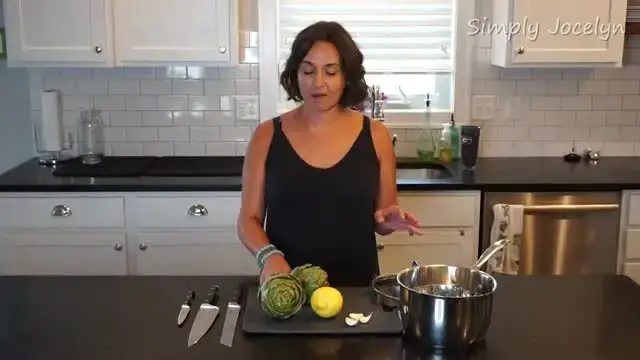Artichokes are a favorite at the Simply Jocelyn house. You can see the family enjoying some artichoke leaves with a bit of beurre blanc.
One of our favorite appetizers or starters.
#artichokes #appetizers #simplesnacks
Follow Jocelyn on Instagram - http://www.instagram.com/jocelynwoltersworld
Follow Simply Jocelyn on Facebook - https://www.facebook.com/Simply-Jocelyn-A-Globally-Inspired-Life-100312851709273/
Grab Some of Jocelyn's Favorite Kitchen Gear
Ninja Blender/Food Processor - https://amzn.to/30F4vXZ
Calphalon Tri-Ply Stainless Steel Cookware - https://amzn.to/30sZ91O
GreenPan Lima Ceramic Non-Stick Griddle - https://amzn.to/2BNCa77
PriorityChef Mortar and Pestle - https://amzn.to/3ff4rCd
Silicone Stretch Lids for Keeping Things Fresh - https://amzn.to/2UvX6pL
Le Creuset Stoneware Butter Crock - https://amzn.to/2UwIxSV
Show More Show Less View Video Transcript
0:00
Hey, I'm Jocelyn and today we're going to take the mystery out of artichokes
0:04
I've been eating these since I was a little kid. I absolutely love them
0:08
And when I find decent ones, I make a lot of them for my family
0:13
So we're going to start out today. I'm going to show you the difference in what you want and what you don't want
0:19
The tighter these are, these are actually buds of flowers. So you want them to be kind of tight right there in the middle
0:26
This one's a little too open. It'll probably be fine. I'm not real worried about the fact that
0:32
the edges are a little bit brown. Sometimes they've just gotten touched by frost and actually
0:37
I think that's something you would like to have. So that's it. So this one's probably not as fresh
0:45
as this one but it'll be fine. So we're going to start by peeling off these little leaves on the
0:51
stem and down at the base of the bud and you can leave them on. It's really not a huge deal
0:59
I love to eat the stem. Not everyone does. It's a little more fibrous, but I do trim just that
1:06
little brown icky part off of it. And then with a paring knife, I just sort of slice off the outer
1:16
edge. You can try a vegetable peeler. I've tried. It doesn't work as well as a paring knife
1:23
but maybe you're better with a vegetable peeler than I. I tend to use knives wherever possible
1:28
So we're just going to peel this off. The other thing you're going to want to do is pick at, maybe use scissors. You can clip all the edges
1:44
of, they're like kind of thorny edges at the end of each leaf. Those will get soft as they cook
1:51
And so you can just leave it if you want. I usually do, but a lot of people are kind of
1:56
you know, hesitant about that, but I don't know, maybe I have hands of steel. It doesn't really
2:00
seem to bother me when I'm slicing them. Um, when you slice off the top, which is our next step
2:06
that might bother you. And so if it, if you think it will go ahead and just trim those off with
2:12
with scissors Alright that looks pretty good So next part we going to cut the tops off of these Serrated knives usually work best and you going to take off about an inch
2:37
All right, so that's done, and I'm going to pull this apart just a little bit. You can see all
2:44
those beautiful layers. I think the artichokes are so amazing. If you've ever seen one actually
2:48
bloom fully, they're just gorgeous. So I'm going to go ahead and pull that open and then do that
2:54
to the second one. All right. Look how beautiful this is. I love it. So I'm going to rinse this out
3:05
and a little bit of water in there is not bad. So we'll do that really quickly at the sink. Okay
3:12
So, I've done that, and I'm going to cut some lemon. I'm just going to cut a wedge, and I'm going to squeeze a little bit of this over the top
3:23
because these things will oxidize quickly. So, I just get a little bit on there so it doesn't get real brown
3:30
And a little lemon juice inside is a good thing. And then the rest of the lemon, I am going to cut up
3:39
and I'm going to put it in my in my water we're going to just steam these for the size of these
3:46
probably about 25 minutes is my best guess so in here in my pot I've already got water
3:53
that comes just to the top of my steamer basket into that I'm going to put some lemon and some
4:00
garlic and I'm just going to take the garlic you can even leave the skin on it doesn't matter we
4:06
just want it for flavoring the water. So there we go. I'm going to peel the skin off anyway
4:15
I'm not going to be picky about it. If some sticks, it sticks. There we go. So I'm going to
4:19
throw that in there. You can maybe add a bay leaf or two. Use your imagination, but for me
4:26
it's lemon and garlic. And then I'm just going to set these in here just like that. And then we're
4:34
going to put it to boil and once it comes to a boil I'm going to reduce it so that it
4:39
just simmers for about 25 minutes and then we have beautiful artichokes to eat
4:55
So our artichokes are all finished so I'm going to take these off the stove and bring
5:00
them over here to my plate. Oh, steamy. Get a facial from that
5:10
And we're just going to set these right there. They're such beautiful things
5:16
I love them. There you go. That's finished. I'm going to squeeze just a little lemon over them
5:29
I love the lemon on everything. and that's the end of that i hope that you'll really love artichokes there i know there's
5:40
something different for most people but they're so good and by the way if you're ever in rome
5:44
in the jewish quarter you absolutely have to get fried artichokes um typically just in the spring
5:51
but let me tell you it is it's worth going in the spring just to get those fried artichokes so i
5:56
should probably teach you how to eat an artichoke. These outer leaves, you can eat part of it. That
6:02
little bit down there is nice and soft, but the rest of it's kind of hard. So with these, you'll
6:08
take it and dip it in your favorite sauce or not. This is my lemon verblanc and it's my favorite
6:13
And you just go like this and scrape it with your teeth. Like that. So as we get further into the choke
6:22
these leaves get softer and softer. You can see like this in the middle or closer to the middle
6:33
You can see my fingernails left a mark in it just by barely touching it. So
6:37
a lot more of the leaf comes off when you use your teeth and pull
6:45
And then you'll get to these center bits. And those are pretty much edible on the bottom
6:58
It's kind of like a process, right? And closer you get in the more you get to eat and you get to the middle and you get to this fuzzy bit My fingers are burning This is so hot So we pull this apart Here the heart in the middle There is
7:27
these last little leaves are so tender. You can just eat them on their own
7:33
And then you get this fuzzy bit. And we want to take that fuzzy bit out
7:37
And you can just set these out and people just peel leaves off and eat them
7:41
But then we'll take the fuzzy part and we just scrape it out
7:51
Oh, God, my hands are burning. My fingers are on fire. So usually I get to that choke after that fuzzy part
8:00
After we've been eating it, it's nice and cold. My fingers can't handle this
8:05
So I'm going to wait and do this in a little bit when this thing isn't on fire
8:09
Okay? And then I'll show you how to eat the heart. Okay, so that was all ridiculously hot
8:15
And usually I can just use a spoon. But it's still pretty warm
8:20
But I don't want to have to film this for hours and hours, quite frankly. So I am just going to take a knife, a little handy-pairing knife
8:29
and I'm just going to cut the fuzzy off. there we go all right i have made a mess of this and it is best just to eat from the outside all
8:49
the way in and then you will have this beautiful heart and it is so tender and i do like the stem
8:55
a lot of people don't but anyway so you get to the heart and that that's that's the gold right
9:02
there. So that is an artichoke and I have made this whole eating process much harder than it
9:10
actually is. But when you eat it the right way with other people and you're peeling off leaves
9:17
it's a really fun, um, you know, like communal event. So I hope that you will get some friends
9:24
together and try some artichokes and not make quite as much mess as I did. See you later
#Cooking & Recipes
#food
#Tourist Destinations



